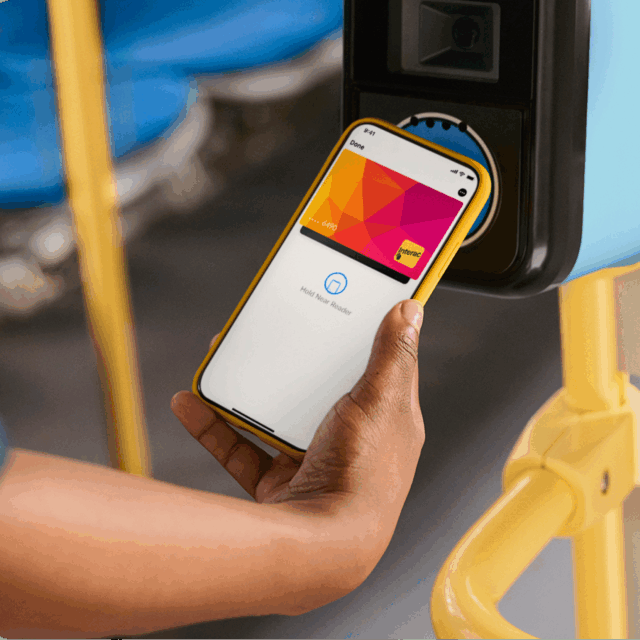Paying for a transit ride by tapping a debit card or smartphone seemed optimistically futuristic as recently as a decade ago. After all, contactless payments were still a brand-new technology, and mobile payments were still just a vision.
Then, in 2012, London started letting riders pay with their existing cards in addition to a dedicated transit pass. The future suddenly became the present. Today, digital payments are rapidly spreading to cities around the world, with riders choosing to make use of newer technologies over traditional tokens, tickets, and non-renewable passes. Additionally, the COVID-19 pandemic has positioned contactless payments as a safer option for transacting, which has led to significant increases in people choosing to transact digitally. What a difference a decade makes.
As transit systems modernize their payment systems, they often evolve. Some systems that used tickets and tokens have evolved to offer riders fare cards that they can recharge and reuse. Open-payment systems often represent the next step, allowing riders to pay with the payment cards already present in their physical and digital wallets.
The advantages of open payments for riders include convenience, lighter wallets with fewer cards, and no more checking a dedicated transit balance before boarding. And, needless to say, opting to use an open-payment system means you can say goodbye to digging through your pocket for coins or tickets.
For transit authorities, upgrading to an open-payment system involves time and commitment, but it brings a number of advantages. As more and more customers switch to digital and contactless payments, for example, one result is shorter queues at kiosks that dispense tickets and passes. Another win: Transit authorities can divert attention away from unproductive tasks such as sorting coins. And open payments also make it easier for occasional riders and tourists to use public transit.
During the post-pandemic recovery period, contactless payments could offer advantages to riders and transit authorities alike. Contactless payments can facilitate physical distancing between customers and staff, and reduce the amount of objects a fare collector has to handle. Commuters who can use their own cards in an open-loop system never have to queue to buy or recharge their method of payment.
Relatively few Canadian municipalities have made the switch to open-payment systems as of now. But on a positive note, that gives our civic leaders and transit experts an opportunity to study and learn from the early adopters.
Here, then, is a tale of three cities that have implemented open-payment systems — namely London, Chicago and Portland.
London
The U.K. capital is often credited with being the first city in the world to pioneer an open-payment system, an experiment that’s widely regarded as a success.
Transport for London (TfL) started letting passengers pay with their own contactless cards on buses in 2012, and rolled out the service across its transport network two years later. Open payments have steadily gained popularity since then: Londoners (and visitors) paid for 22 million journeys a week, or at least half of all rides, with their own cards as of 2019.
Some Londoners are moving beyond cards altogether: By 2019, one in eight TfL trips was being paid for with a mobile wallet app.
LEARNINGS:
Riders who are already in the contactless habit may switch easily. British financial institutions and consumers were early and enthusiastic in embracing contactless payment — just as they have been in Canada. Adoption of open payments for Tube and bus rides was aided by the fact that many customers were already accustomed to paying with a tap by the time TfL introduced open payments starting in 2012.
Customers benefit from a capped-fare structure. A key benefit of TfL’s system for commuters is the promise that its system will automatically calculate the lowest available fare for a journey when they use contactless payment. For example, riders who use a contactless card have their fares capped at a daily maximum that corresponds to the cost of a day pass. That means there’s never a cost disadvantage compared to traditional fare media.
Open payments means simplifying other aspects of a transit system. Strong adoption of open payments has allowed TfL to stop taking cash on buses, to streamline ticketing booths at stations, and to reduce crowds at busy stations (since people don’t need to “hang around” to purchase fares).
Chicago
In 2013, three Chicago-area agencies — the Chicago Transit Authority (CTA), Metra and Pace — launched Ventra, a joint open-payment system also introduced a refillable balance card, replacing proprietary magnetic strip cards that had been introduced in the 1990s.
At the time, the CTA’s general manager of business development articulated a key motivation for moving to open payments: The authority would save US$5-million a year because it would no longer be, in effect, “issuing private currency,” with all the costs of creating and administering fare media.
Some challenges emerged as the system rolled out: Riders perceived Ventra’s initial 2.5 second delay to confirm a swipe as too long, for example, and there were reports of other glitches in the system.
In the years since, steady improvements (including faster processing speed) have eased concerns. By 2017, the CTA was reporting 85 per cent approval of the Ventra app in a customer satisfaction survey, and a 90 per cent approval score for “ease of fare payment.”
LEARNINGS:
Avoid surprises. Transit agencies and payment providers should take the opportunity before the rollout to educate customers and front-line staff about new fare solutions, which may be hard for some people to understand.
An open-payment system must be fast, or else breed frustration. Technical updates may be required to ensure open payment transactions are quick enough for transit.
Portland
The Tri-County Metropolitan Transportation of Oregon (TriMet) serves an area that mostly overlaps with the metropolitan statistical area of Portland, Oregon (population 2.5 million). It launched the Hop Fastpass in 2017.
Hop Fastpass is not only an open-payment system, it’s an open open-payment system, in the sense that it was developed around an open infrastructure model. TriMet wanted to avoid being tied to a single vendor to deliver the whole system. As the authority’s fare administrator explained in a case study for the American Public Transportation Association: “You can have a seamless cooking experience without all your pots and pans being from the same company.”
By May 2019, eight per cent of Hop users paid by mobile wallet, seven per cent with contactless debit and credit cards, and the other 85 per cent of rides were still paid for with the proprietary purple Hop card. Those adoption rates for contactless debit and credit may seem modest to Canadian readers, but they were a success given how low the penetration of enabled cards was in the United States at the time.
LEARNINGS:
Flat fares can simplify an open-payment rollout. Planners set the stage for Hop Fastpass by replacing a zoned fare system with a flat US$2.50 fee.
TriMet regards the upgrade to open payments as an important future-proofing project. For example, an open-payment infrastructure is serving as a cornerstone for the development of a multimodal mobility wallet, and TriMet plans to integrate payment into its trip planner.
Next stop: Canada?
There’s a lot of unexplored potential for open-payment systems among transit authorities in Canada — and one major factor that could help assure successful adoption here: 94 per cent of the population is reachable through a single payment option, Interac Debit.
When Interac Debit is incorporated into an open-payment system, the service will be accessible to almost 30 million Canadians. Eighty-two per cent of Canadians already pay with debit for their day-to-day purchases, and, thanks to the prevalence of Interac Flash, more than half of those transactions are contactless. In other words, many Canadians already prefer to pay contactlessly with a debit card. Using it to board a bus, train or subway would be a natural evolution.
And because they facilitate physical distancing, contactless payment systems could be part of the solution to help transit systems and riders feel comfortable and secure again. Beyond that, Canadian transitriders are like people anywhere else: They appreciate convenience — and they’re eager to find out how technology can deliver them a better journey from point A to B.
_____
*Payment options depicted are intended to show examples of what the future of modernized transit payments could look like, and do not reflect products actually available in market.*
Interac is a registered trade-mark and the Interac logo is a trade-mark of Interac Corp.
The Contactless Indicator mark, consisting of four graduating arcs, is a trademark owned by and used with permission of EMVCo, LLC.





